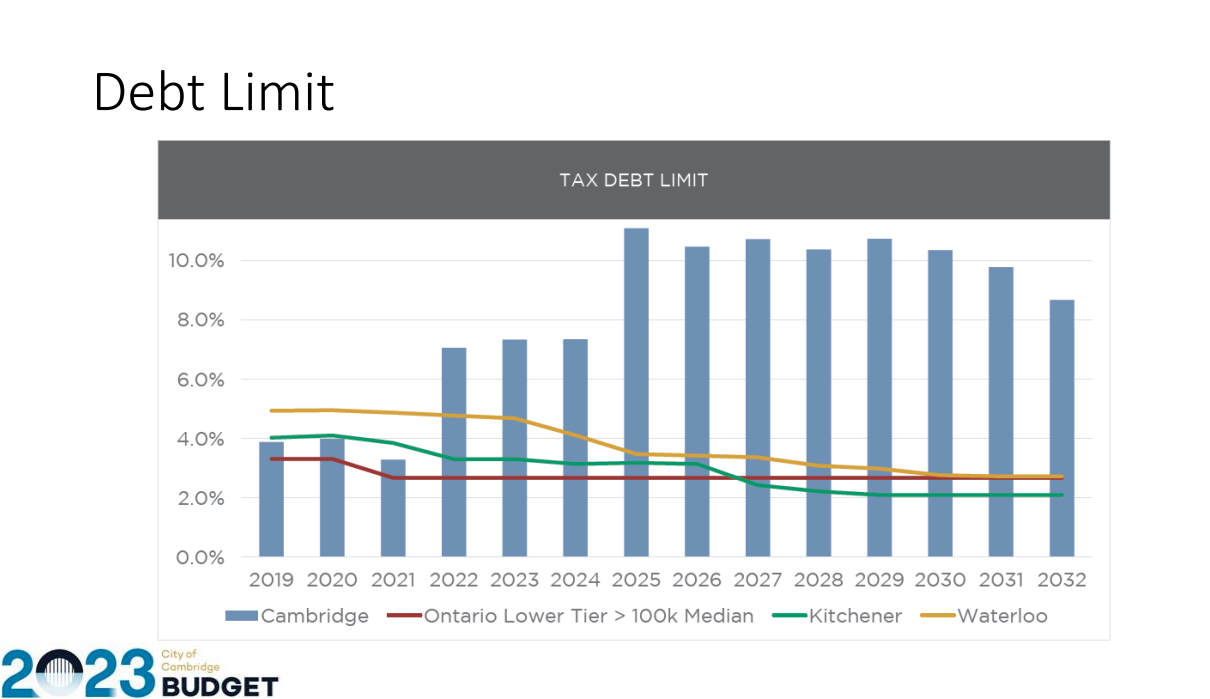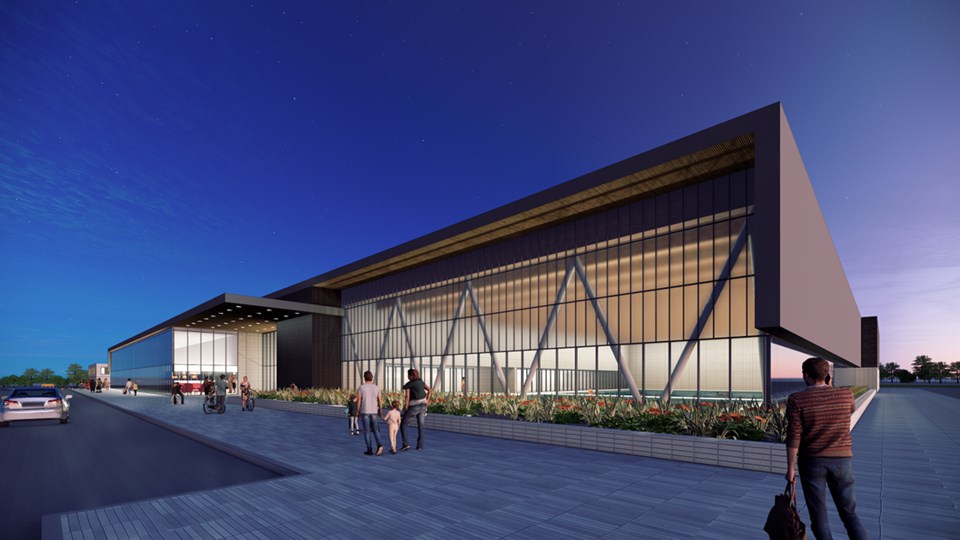The projected cost of the new Cambridge Recreation Complex continues to creep upwards along with inflation, and is now expected to add close $24 million to the original budget.
Council heard the news Thursday to alleviate sticker shock in the lead up to final design and budget figures for two build options expected to return to council for consideration in March.
With inflationary pressures causing a 15.6 per cent jump in the construction price index, the cost of the project is now expected to top $107 million for the full build and $97 million for a modified build with reduced amenities.
That's an increase of $23.9 million and $13.5 million over cost estimates presented earlier this year.
Council also heard from the city's chief financial officer that going with the full build would push the city's debt limit to close to 12 per cent, while remaining within a 15 per cent threshold the city sets to manage its debt.
The south-end complex would house a 10-lane, 25 metre swimming pool and warm water leisure pool, gymnasiums, running track and multi-purpose rooms and a branch of the Cambridge Idea Exchange public library.
Set to open in 2025, council also learned there would be an option to delay the project to wait for government grants to help shoulder some of the design and construction costs.
Those costs jumped from an initial budget target of around $60 million when a location was confirmed and an early concept first gained traction in 2020.
The budget was reassessed in May, then in August the city hired MacLennan Jaunkalns Miller Architects Ltd. to move ahead with two options; a full build, with an estimated price tag of $101 million, and a modified build meeting the new forecasted budget target of $83.5 million.
The full build would include a 10-lane pool, a running track, three gymnasiums and library, while the modified build would include an eight-lane pool, walking track, two gymnasiums, no bleacher seating, fewer change rooms and smaller library.
A design team comprised of architects and city staff, led by project management firm Colliers, has been meeting every two weeks since then to hammer out the details.
Those details, presented as part of a concept design and costing update at Thursday's budget and audit committee meeting, include predicted impacts from inflation and other factors like war, COVID and high interest rates, all of which will continue to put pressure on the construction industry for the foreseeable future.
Even without those pressures, the sheer number of community centre projects still planned for southern Ontario is having an impact on prices, said Ron Spina, from Colliers.
Spina said the design work that’s been done to date is to LEED Gold standard, adding a goal to achieve net-zero carbon would require further funding.
The design includes elements of net-zero carbon that would be hard to retrofit. Among those features is an electrified heating system, high R-value insulation and measures to minimize water use.
The steering committee is hopeful the final design will allow the city to apply to the federal Green And Inclusive Community Buildings Program. An application for the first intake for that grant wasn't successful, but Spina believes the city has a better chance once a final design in place.
He offered cautious optimism because of heavy competition from other communities. Securing that grant would shave between half a million to a million off the project, he said.
Public consultation on the project, around smaller aspects of the design, is currently underway through the Engage Cambridge website.
Spina said the next design milestone will come in January with a concept that will look at three dimensional massing of the building, access to the site, the multi-use trail, parking, and landscaping.
A more detailed cost estimate will also come in February, but he doesn't expect it to be significantly different because the latest figures include an "escalation estimate" of 7.5 per cent annually to the start of construction.
Spina said they could also consider a further reduced design option that council took off the table last year.
But Mayor Jan Liggett recommended they not bring that option back because it was “just ludicrous to even consider it” after going through so many years of looking at designs. The rest of council agreed.
City CFO Sheryl Ayres told council that any additional funding needed for the project would require the city to take on debt, adding the tax implications for carrying a debt load of $1,200 per capita over a 20-year term would be .4 per cent impact on the annual levy.
The unknown in all of this, cautioned Ayres, is the impact of Bill 23, which the city is still analyzing. She said it appears it will significantly impact revenues and will further impact tax rates.
“It would be fiscally prudent to ensure the city is not getting into a position where we are limiting our debt capacity to fund other necessary capital works,” she cautioned.

Ayres said it's also important to consider the impact that debt will have on the city’s tax levy, particularly relative to its neighbour municipalities.
A comparison of municipal debt loads per capita shows Cambridge is currently “slightly above the midpoint” compared to other lower-tier large municipalities
That debt level sits around $400 per capita but would rise to about $1,200 per person by 2024 if council chooses to go ahead with the full build on the rec centre.
That additional debt would put Cambridge at the highest end of the range for total debt per capita against all the Ontario lower-tier large municipalities included in the study, Ayres said.
Liggett said she took that as a recommendation to cancel the sports complex, but Ayres said the decision is ultimately council’s and she is simply stating the facts.
Although the impact of Bill 23 has yet to be fully explored by the city, Ayres said it has already resulted in a $1.5 million impact on the 2023 budget due to lost development charges and other fees.
The city will need to fund that loss through other sources, including the tax levy, and staff expects that impact will grow in future years.
The steering committee for the rec complex has considered other options, including proceeding with the design but pausing construction until there’s a better opportunity to access government grants.
Coun. Scott Hamilton asked if not going ahead with the project could end up being more expensive to the city in the long run as existing facilities demand higher maintenance costs and are in “dire need of replacement.”
Coun. Kimpson echoed Hamilton’s concern.
“The facilities we have now, they’re bursting at the seams and they’re in need of repair. We haven’t had any significant investment in our recreation facilities in a number of years and that’s something I’m hearing from members of the community all over and not just in my ward.”
She referred to the per capita debt graph that showed the City of Waterloo’s debt level within the lower tier average after years of higher debt due to the construction of facilities like RIM Park and the Waterloo Recreation Complex, amenities the community now gets to enjoy.
“I do want to give this some serious consideration that we do what we can to get this off the ground and get this moving because the longer we delay the more it costs,” she said.
City manager David Calder agreed Waterloo is a good example of the ebbs and flows of debt levels and that Cambridge would experience the same if council goes ahead with the project, while ensuring the city remains within its debt limit.
“We’re just raising the caution that this is the second increase in the project’s cost that we’ve reported on,” he said.
The intent of the presentation was not to pass judgment on the sports complex but rather not to wait until March to show the inflationary impacts, he added.
“We wanted to be open, transparent and keep you informed as to what we are seeing in terms of the price increase,” he said.
The March presentation will provide an opportunity for council to debate the merits of different aspects of the project and consider alternative solutions to funding it if there are any available at that point, he added.



